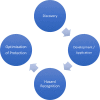Evolution of radiation protection for medical workers
- PMID: 32496817
- PMCID: PMC7446021
- DOI: 10.1259/bjr.20200282
Evolution of radiation protection for medical workers
Abstract
Within a few months of discovery, X-rays were being used worldwide for diagnosis and within a year or two for therapy. It became clear very quickly that while there were immense benefits, there were significant associated hazards, not only for the patients, but also for the operators of the equipment. Simple radiation protection measures were implemented within a decade or two and radiation protection for physicians and other operators has continued to evolve over the last century driven by cycles of widening uses, new technologies, realization of previously unidentified effects, development of recommendations and regulations, along with the rise of related societies and professional organizations. Today, the continue acceleration of medical radiation uses in diagnostic imaging and in therapeutic modalities not imagined at the turn of this century, such as positron emission tomography, calls for constant vigilance and flexibility to provide adequate protection for the growing numbers of medical radiation workers.
References
-
- UNSCEAR Sources and Effects of Ionizing Radiation. United Nations Scientific Committee on the Effects of Atomic Radiation. UNSCEAR 2008 Report to the General Assembly with Scientific Annexes. Volume I. New York: United Nations; 2010.
-
- NCRP Ionizing radiation exposure of the population of the United States. NCRP Report No. 160. Bethesda, MD: National Council on Radiation Protection and Measurements; 2009.
-
- Gagliardi R. A, Almond P. R. A History of the Radiological Sciences: Radiation Physics. Reston, VA: Radiology Centennial, Inc; 1996. .
-
- Dauer LT. Exposed medical staff: challenges, available tools, and opportunities for improvement. Health Phys 2014; 106: 217–24. - PubMed
Publication types
MeSH terms
Grants and funding
LinkOut - more resources
Full Text Sources
Medical


